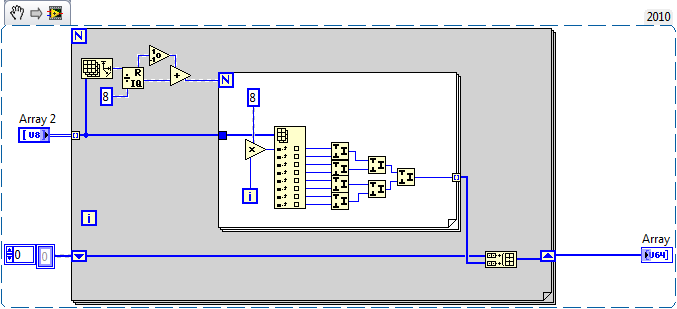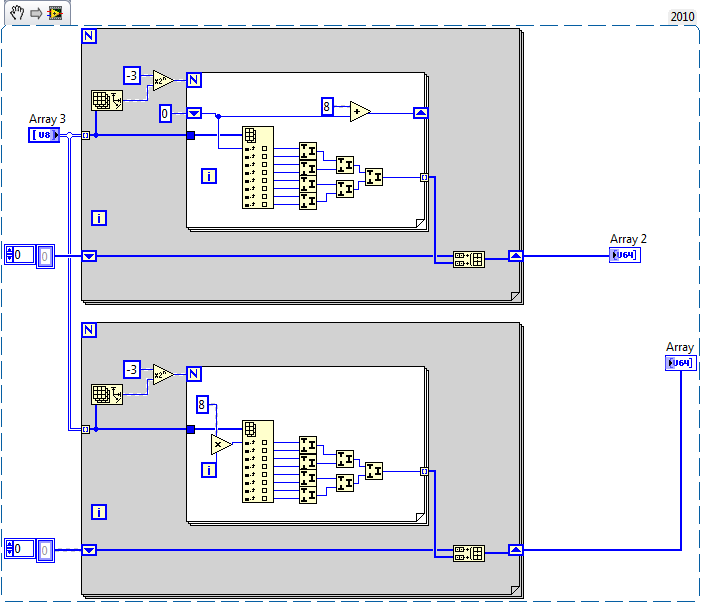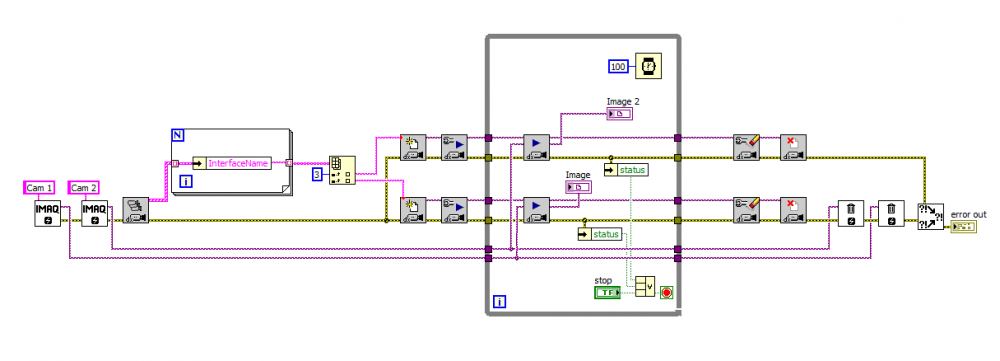
SuperS_5
-
Posts
129 -
Joined
-
Last visited
Content Type
Profiles
Forums
Downloads
Gallery
Posts posted by SuperS_5
-
-
Have you checked your system logs to see if LabVIEW left any error messages. Often there will be an error left there, even when no dialog box shows up. In any case, it kind of sounds like the computer is running out of resources. My first guess would be RAM. Check to see if your endlessly building an array, or some other memory leak. You did not post any code for us to look at, so that will make things difficult. (I am talking about sterilized code of course.)
-
-
Sounds similar to an issue I had once. The provider changed the server I was hosted on and required me to update my NS records to the new server. I added all the new ones but I missed deleting one of the old ones (although I could swear blind I got them all). The result was intermittent DNS lookups because there was a 1 in 3 chance the lookup was done through the old one..
I have Google DNS servers set on my routers. This issue does not discriminate between my wireless or hardwired connections. Accessing LAVA has been flawless since I added the IP to the hosts file. This leads me to suspect there is a bad DNS record for LAVA floating around somewhere out there.
Edit: apparently someone switched the DNS server on the router here, so no Google DNS. After switching to Google DNS on this machine, LAVA is good again. Very interesting.
-
This problem occurs on 2 separate networks (Home, and work; both have desktops that can access LAVA)
PS: RSS feeds continued to worked sporadically via outlook.
-
Hey guys,
The previous post about this was locked, so I couldn't reply there, but I have the same issue. DNS resolution to lavag.org from my laptop fails >80% of the time. I have temporary fixed it by putting lavag in my hosts file. Hopefully you guys won't change your IP too often. The really odd thing is that I can access LAVA from my desktop, and I can access every other website I have tried from my laptop. I have tried flushing my DNS cache, but the problem persists.
-
Hi,
I use a variant to the JKI state-machine for almost all of my work. It is a strategy that has it's purposes. Generally it is used for UI loops, where states are only executing after some user interaction. It can be used in other situations too, but this I prefer this type of state-machine for UI loops. (Semi-)deterministic architectures will differ for their specific needs. States generally execute quickly, unless the user is required wait for something. (I used a busy cursor when it is desired for the user to wait.) If the states do not execute quickly, (such as timeout case - screen updates) I would optimize/strip the code until it is within the responsiveness requested. Anything that is required to always run, but, does not execute quickly enough, another loop will be used.
-
Too bad LabVIEW is not on the screens.

-
You can use a property node or local variable to change the value of a control. There are many resources available for this. Any bar-code reader that outputs text, like a keyboard will work without any trouble. Other bar-code readers may require interfacing with a dll, which is an advanced topic and makes life difficult.
-
Well I was asked for some kind of demo code because I can't figure out your "prototype" and the options inside the Call Library Function Node. (CLFN) Passing the pointer to anything is fairly easy if you use the right options in the CLFN. If the dll returns only after updating the values, then life is simple. If the dll returns immediately, then continues to update the values, life gets more complicated. When this sub-vi terminates, LabVIEW will un-reserve the memory for the constant/control used and will then reuse that memory space. This can cause lots of problems as your dll overwrites LabVIEW memory. From what I can see in the picture, your prototype/options for the CLFN are a little messed up, but can't put my finger on it.
-
-There is still a perception that VB is not a language for serious programming. (Reality doesn't matter if the hiring manager believes it to be true.)
LabVIEW definitely falls into this category. I have no idea how many times I have tried to explain that I actually program entire programs in LV to text only programmers. They almost never believe me. (Sometimes even after showing them LV examples)
-
 1
1
-
-
Hi, I couldn't quite follow your picture. Please post an example of your code. Also, are you sure that your function actually works? If called from somewhere else, does it returns values?
-
Hi,
This is the error from Signal Express:
Error -200077 occurred at DAQ AssistantPossible Reason(s):
Requested value is not a supported value for this property.
Property: SampTimingType
You Have Requested: On Demand
You Can Select: Sample Clock
Device: cDAQ12
You cannot use this device in this configuration. In LabVIEW you can use the "Set Clock" vi to use something like the "OnboardClock." Although I guess this is not true "Sample on demand", however, the "Get 1 Sample" function gets only the last value. (So it looks like on demand sampling)
-
Hi,
This sounds like a perfect application for the vision module. If you can get the module, it should be fairly easy to compete that task.
-
Hi, I do not know about any PBKDF2 implementations, however I did find some help from Google. I looked for PBKDF2 and found a page that computes this, returning the result to the user. (Second listed: http://anandam.name/pbkdf2/) The source of that page is fairly easy to follow, and I am not a Java programmer either. The PBKDF2 seams to be a very specific way of using the SHA-1 encryption. (I could be wrong, I spent a whole 2min looking around, and have never used PBKDF2 before) There are SHA-1 LabVIEW implementations available. (http://decibel.ni.com/content/docs/DOC-10292) Using both of the source of http://anandam.name/pbkdf2/pbkdf2.js as an example and the SHA-1 implementation, you may have some luck. Good luck.
-
The execution seams a little weird to me, but it still shows the basic state machine in action. Kudos.

-
Hi, when I first tried Win7 beta, LabVIEW 8.6 wouldn't install nicely. When I received my win7 (Pro64bit) laptop, I didn't have an issue installing 8.6. I currently still use 8.6 for some projects, although I am in the process of changing to 2010. (Just love the "separate compiled code" too much) DAQ also seams to work OK with win7 and LV8.6. The only problem I had was the font/system control changes between XP and Win7. When everything installed nicely, I abandoned the use of VirtualPC for LabVIEW use.
-
Kudos Daklu. You took the words right out of my mouth, then added several times over. I am actually inspired to look for more architectures and styles. After all I want to go for the CLA test sometime after I take my CLD test coming up.
-
I really like JKI's TSVN plugin when I need to commit/update/rename one file at a time. Projects are still a little troublesome from within LabVIEW. (At least for me. Sometimes I don't read instructions well.
 ) There seams to be a TortoiseNNN for everything now. <Laughing to self> The tortoise shell integration is a really cool concept, and seams to work well across different versioning systems. Just to add too CommonSense's comment, there is also a TortoiseGit and TortoiseBzr. (Bazaar) There are probably more too, I just can't find them all. (In development/planning)
) There seams to be a TortoiseNNN for everything now. <Laughing to self> The tortoise shell integration is a really cool concept, and seams to work well across different versioning systems. Just to add too CommonSense's comment, there is also a TortoiseGit and TortoiseBzr. (Bazaar) There are probably more too, I just can't find them all. (In development/planning)Edit: From Wikipedia
- TortoiseCVS, a GUI integrated CVS client for the Microsoft Windows platform
- TortoiseHg, a GUI integrated Mercurial client for the Microsoft Windows platform
- TortoiseSVN, a GUI integrated Subversion client for the Microsoft Windows platform
- TortoiseGit, a GUI integrated Git client for the Microsoft Windows platform
- TortoiseBzr, a GUI integrated Bazaar client for the Microsoft Windows platform
-
Hi,
Although I have only have a few years of experience with LabVIEW, I have always used the string based state machine with a event structure. (Very similar to the JKI state-machine approach) I don't have any issue with the Enum and Queued versions of the state-machine, I prefer the string version. (I found it to have more advantages then disadvantages.) Of course this is only the UI side of the application. The UI thread is only a portion of the overall architecture. Anything that needs to run without interruption (like DAQ) will have their own structures. (Usually some form of simple state machine)
-
Hi,
I personally stumbled upon SVN/TSVN while trying find any revision control system. It just worked right out of the box, and have been very happy with the performance and safety it provides. I then found trac, which improved upon the system even further. I have started to experiment with other revision/source control systems, such as git and bazaar, but still like SVN by far. It is simple and customizable to almost any need.
-
Here is an example. It took a while to get my second cam working with this new laptop to test it out. For some reason I couldn't make this a code snippet, but all well, here is just the pic.
Edit: I used one loop here for simplicity, you could have them in totally separate loops if needed. You could also call them sequentially.
-
Could you post your example code. If you are using IMAQ, this is fairly easy.
-
Hi,
Do you have any thing done yet? Do you have a LabVIEW related problem that we can help with, or do you want us to do your work for you? I am not trying to be mean, but you have not posted anything about any solution that you have generated yourself. This seams like a generic use case for a simple state machine. There are many resources available to help with the architecture concepts if you need it. (There are also resources to help with LabVIEW programming too.)
-
Hi. It looks like ShaunR is more knowledgeable in this area, so I will try to keep my foot out of my mouth. I would guess that NI would want to optimize the primitive for default use. It would seem that the default "0" automatically performs some optimizations. A non-zero value forces the primitive to actually iterate the exact number of times that you specify. When attempting to reproduce your graphs, it did not work on very low number of data points. The primitive must have some sanity checks to prevent all of the points from being removed.




I can't get IMAQ WindDraw to work with 2 displays
in Machine Vision and Imaging
Posted
I didn't see your second post until I tried the VI, so I can verify that it works on 2 monitors using the same graphics card.